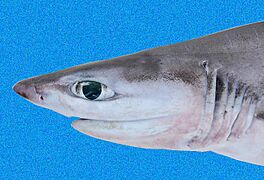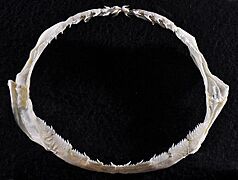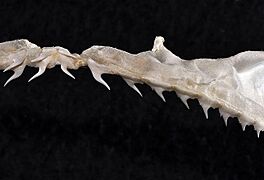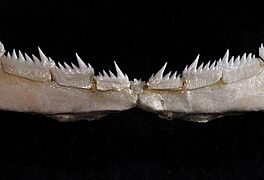Sharpnose sevengill shark facts for kids
Quick facts for kids Sharpnose sevengill shark |
|
|---|---|
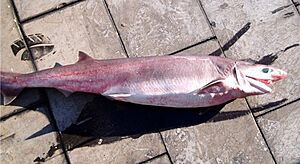 |
|
| Conservation status | |
| Scientific classification | |
| Genus: |
Heptranchias
|
| Species: |
perlo
|
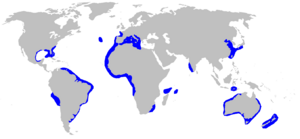 |
|
| Range of the sharpnose sevengill shark | |
| Synonyms | |
|
Heptranchias angio Costa, 1857 |
|
The sharpnose sevengill shark (Heptranchias perlo) is a unique type of shark. It's also known by other names like the one-finned shark or perlon shark. This shark belongs to the Hexanchidae family. It is the only living species in its group, called Heptranchias.
You can find this shark in deep waters all around the world. What makes it special is that it has seven pairs of gill slits. Most sharks only have five. The only other shark with seven gill slits is the broadnose sevengill shark. Even though it's not very big, the sharpnose sevengill shark is a strong and hungry hunter. It eats small sea creatures without backbones, called invertebrates, and other fish. If this shark is caught, it will try to bite to defend itself. It is sometimes caught by fishers, but it's not a major commercial fish.
Contents
Shark Names: What's in a Name?
The name Heptranchias comes from ancient Greek words. Heptra means "seven arms" and agchein means "throttle." This name points to the shark's seven pairs of gill slits. People also call this shark by many other names. These include the one-finned shark, perlon shark, and sharpnose seven-gill shark. Some scientists even think this shark is so different that it should have its own family, called Heptranchiidae.
Where Sharpnose Sevengill Sharks Live
The sharpnose sevengill shark is not very common, but it lives in many places. You can find it in warm and mild parts of all oceans. However, it's not found in the northeastern Pacific Ocean.
In the western Atlantic, it lives from North Carolina down to Cuba. This includes the northern Gulf of Mexico. It also lives from Venezuela down to Argentina. In the eastern Atlantic, it's found from Morocco to Namibia, including the Mediterranean Sea. In the Indian Ocean, it has been seen near southwestern India, Aldabra Island, southern Mozambique, and South Africa. In the Pacific Ocean, it lives from Japan to China, Indonesia, Australia, New Zealand, and northern Chile.
This shark usually lives near the seafloor or swims in the open ocean. It is often caught at depths of 300 to 600 meters (about 980 to 1,970 feet). Sometimes, it's found closer to the surface or as deep as 1,000 meters (about 3,280 feet). It mostly lives on the outer edge of the continental shelf and the upper continental slope. These sharks might gather around underwater mountains called seamounts.
Sharpnose Sevengill Shark Appearance
Sharpnose sevengill sharks are usually 60 to 120 centimeters (about 2 to 4 feet) long. The longest ones can reach about 1.4 meters (4.6 feet). This shark has a slim, torpedo-shaped body. Its head is narrow and pointed. The eyes are very big and glow green when the shark is alive.
Its mouth is narrow and curved. Inside, it has 9-11 teeth on each side of its upper jaw. It has five teeth on each side of its lower jaw. The upper teeth are thin and hook-shaped with small points on the sides. The lower teeth are wide and look like combs. Unlike most sharks, it has seven pairs of gill slits that go down onto its throat.
It has one small dorsal fin (top fin) located behind its pelvic fins (bottom fins). This fin has a straight front edge and a rounded tip. The pectoral fins (side fins) are small. The anal fin (fin near the tail) is also small. The part of the body before the tail, called the caudal peduncle, is long.
The shark's skin is covered in tiny, thin, clear scales called dermal denticles. Each scale is longer than it is wide. It has a clear ridge in the middle and two ridges on the sides. The shark's color is brownish-gray to olive on top and lighter underneath. Some sharks have dark spots on their bodies. Young sharks have dark spots on their sides and dark tips on their dorsal fin and upper tail fin.
Life and Habits: What They Eat
Even though it's not a huge shark, the sharpnose sevengill shark is a top predator in its ocean home. For example, at the Great Meteor Seamount in the eastern Atlantic, these sharks mainly eat bony teleosts and cephalopods (like squid and octopuses). They also eat some smaller cartilaginous fishes (fish with cartilage instead of bones).
Off the coast of Tunisia, crustaceans (like crabs and shrimp) are the second most common food after bony fish. Near Australia, they mostly eat bony fish. Smaller sharpnose sevengill sharks prefer Lepidorhynchus denticulatus. Larger sharks eat more snake mackerels and cutlassfishes. This shark is a strong swimmer. It hunts and is more active at night. Bigger sharks might hunt the sharpnose sevengill shark. This shark can also have tiny creatures called parasites living on or in it.
Reproduction and Life Cycle
Sharpnose sevengill sharks reproduce in a way called ovoviviparous. This means the eggs hatch inside the mother's body. The pups then develop inside her, getting food from a yolk sac. There doesn't seem to be a specific time of year when they reproduce.
Female sharks give birth to 9 to 20 pups at a time. Newborn sharks are about 26 centimeters (10 inches) long. Male sharks become mature when they are about 75 to 85 centimeters (2.5 to 2.8 feet) long. Females become mature when they are about 90 to 100 centimeters (3 to 3.3 feet) long. When male sharks are ready to reproduce, a special mucus might form on the tips of their claspers (parts used for reproduction).
Sharpnose Sevengill Sharks and People
The sharpnose sevengill shark is fairly small and lives in deep water. Because of this, it is generally considered harmless to humans. Sometimes, these sharks are accidentally caught by deepwater commercial fisheries. They might be caught on longlines or in large nets called trawls.
These sharks are sometimes used for fishmeal (food for other animals) and liver oil. People say the meat tastes good, but it can be slightly poisonous to eat. When caught, the shark is very active and quick to bite. However, because of its small size, it's not a big threat to people. Occasionally, some have been kept in aquariums in Japan.
Conservation Status
Scientists are a bit worried about the sharpnose sevengill shark population. These sharks reproduce slowly. In areas where a lot of deepwater fishing happens, their numbers might be going down. Because of this, the World Conservation Union has listed it as "Near Threatened". In June 2018, the New Zealand Department of Conservation called the sharpnose sevengill shark "At Risk – Naturally Uncommon." This means it's naturally rare in New Zealand waters.
Interesting Fact
On September 26, 2019, a dead sharpnose sevengill shark was found on the beach of Torre Pali. This is a small town in Salento, Italy.
See also
- List of prehistoric cartilaginous fish genera



